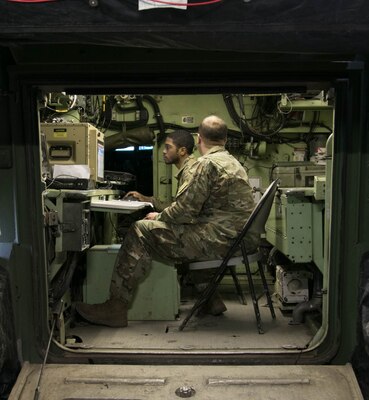By Army Staff Sgt. Sharon Matthias, 22nd Mobile Public
Affairs Detachment
GRAFENWOEHR TRAINING AREA, Germany, Feb. 5, 2018 — A team of
soldiers assigned to 1st Battalion, 7th Field Artillery Regiment, trained with
members of the 2nd Battalion, 70th Armor Regiment, during a live-fire training
exercise here, Feb. 2, 2018.
The goal for the units, both part of the 1st Infantry
Division’s 2nd Armored Brigade Combat Team, was to gain confidence in their
ability to work together.
“The objective for my battalion in this ‘walk and shoot’ is
to provide fires for 2-70th maneuvers -- to give those company commanders and
young forward support officers in that battalion the confidence to rely on
field artillery to provide fires for them,” said Army Command Sgt. Maj. Michael
Deatherage, 1st Battalion, 7th Field Artillery Regiment.
Training like this gives junior leaders a chance to develop
and enhance offensive, defensive and stability tasks.
Army 1st Lt. Dylan Hatch, a platoon leader assigned to 1st
Battalion, 7th Field Artillery Regiment, said he believes the greatest
opportunity derived from the training was the ability to work with 2nd
Battalion, 70th Armor Regiment’s forward observers.
Requesting Artillery Support
When forward observers relay information on enemy activity
in a ‘call for fire’ to artillery troops such as Hatch, the artillery crews
respond with speed and precision.
The call for fire activates a rapid response from the unit’s
M109A6 Paladin howitzers, firing 155 mm rounds accurately within minutes. This
complex task requires the utmost in proficiency and teamwork by every soldier.
Each artillery crew member has a separate and specific task
when a call for fire comes in, such as moving the vehicle into a firing
position, computing the target's data in the gun settings, loading the
ammunition and firing on the target.
Army Pfc. Brian Mulcay, a cannon crewmember assigned to 1st
Battalion, 7th Field Artillery Regiment, said, “My job as the ‘No. 1 man’ [a
crew slogan] is to make sure all the ammunition in the vehicle is sorted
properly, fuse the ammunition for firing, load the 95-pound rounds and fire the
155 mm high-explosive ammunition.”
The unit’s network of operators and systems can provide
joint fires, fire support and counterfire, while shooting, moving and
communicating within an assigned area.
While all this may sound easy and simple on paper, the
on-the-ground conditions in which the soldiers and their equipment must work
can be grueling. Understanding the limits of their equipment and how to care
for it is of great importance to the soldiers, a fact that isn’t lost on their
leaders.
“These soldiers are doing an outstanding job at keeping our
operational readiness rate at a peak throughout this operation,” Deatherage
said. “Our equipment has been exercised to the max and I am very impressed with
our ability to keep our 18 guns in the fight.”

No comments:
Post a Comment